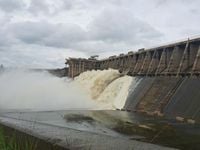The Vaal Dam has reached a concerning 120.69% capacity as of Saturday, April 26, 2025, following a significant increase of 2.21% since the previous day. This surge in water levels prompted the department of water and sanitation (DWS) to open the 10th sluice gate, which was activated as the dam water levels reached a critical rate of 118.48%. The decision to open additional gates was made in response to a dramatic rise in water levels, which increased by approximately 6.36 percentage points in just 24 hours due to heavy rainfall in the region.
As of Saturday morning, the dam recorded a substantial inflow of 2,214.5 cubic meters per second (m³/s) and an outflow of 2,116.0 m³/s, although officials noted that the outflow figures were still pending confirmation. Downstream, the Vaal Barrage showed water levels at 6.9 meters, matching the outflow rates of 2,116.0 m³/s. The water temperature at the barrage was recorded at 15.5°C.
The recent opening of additional sluice gates has sparked mixed reactions among local residents and business owners. While some community members voiced their dissatisfaction with the decision, labeling it "disastrous," others, like a local business owner, viewed it as a potential opportunity to attract visitors interested in observing the river flowing into the dam.
On Thursday, April 24, 2025, six gates were opened as part of a flood management strategy. However, rapidly rising water levels necessitated further measures. The DWS is closely monitoring the situation as it strives to balance dam safety with concerns about downstream flooding.
Wisane Mavasa, a spokesperson for the DWS, explained that the water levels in the Vaal Dam had risen rapidly overnight due to heavy inflows from the upper catchments, driven by continuous above-normal rainfall on already saturated grounds. Mavasa stated, "As such, the department of water & sanitation (DWS) will be opening an additional four sluice gates gradually today from 9am, 10am, 12 noon and the last one at 1pm this afternoon." This was part of a broader strategy to manage the increasing water levels.
With the dam sitting at 118.48% and an inflow of 2,448 m³/s, the DWS took decisive action. The adjustments made at the Bloemhof Dam also reflected the urgency of the situation, with water outflows being increased incrementally throughout the day. The outflow rates were set to rise from 2,000 m³/s to 2,800 m³/s, emphasizing the need for careful management of the rising inflows.
At Grootdraai Dam, the already opened gate was increased to 2.5 meters due to higher inflows of 967.47 m³/s, with plans to further increase it to 3 meters at 9 am on Saturday and to open a second gate at 11 am. The storage level at Grootdraai Dam was reported at 110.08%.
In the Orange River, the Gariep and Vandekloof Dams are currently at 108.25% and 106.09% respectively and are overspilling. The DWS warned that the controlled and uncontrolled water releases from these dams could lead to overtopping of riverbanks downstream of both the Orange and Vaal rivers, resulting in flooding in settlements located in lower-lying areas within the 100-year floodline.
Residents living within this floodline, especially those downstream of the Vaal and Bloemhof Dams, have been urged to evacuate and avoid flooded areas, as the river catchment remains oversaturated.
As the situation continues to evolve, the DWS remains vigilant, emphasizing the importance of public safety. The agency's ongoing efforts to monitor and manage the dam levels reflect a commitment to preventing potential disasters while balancing the needs of local communities.
In summary, as heavy rainfall continues to affect the region, the opening of sluice gates at the Vaal Dam has become a critical part of flood management efforts. The DWS's proactive measures aim to mitigate risks associated with rising water levels and ensure the safety of residents living in vulnerable areas.

